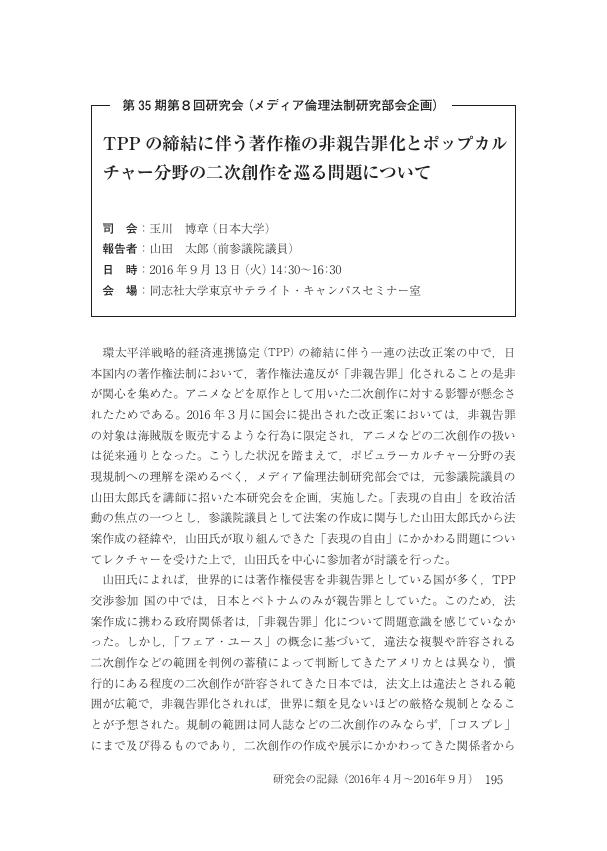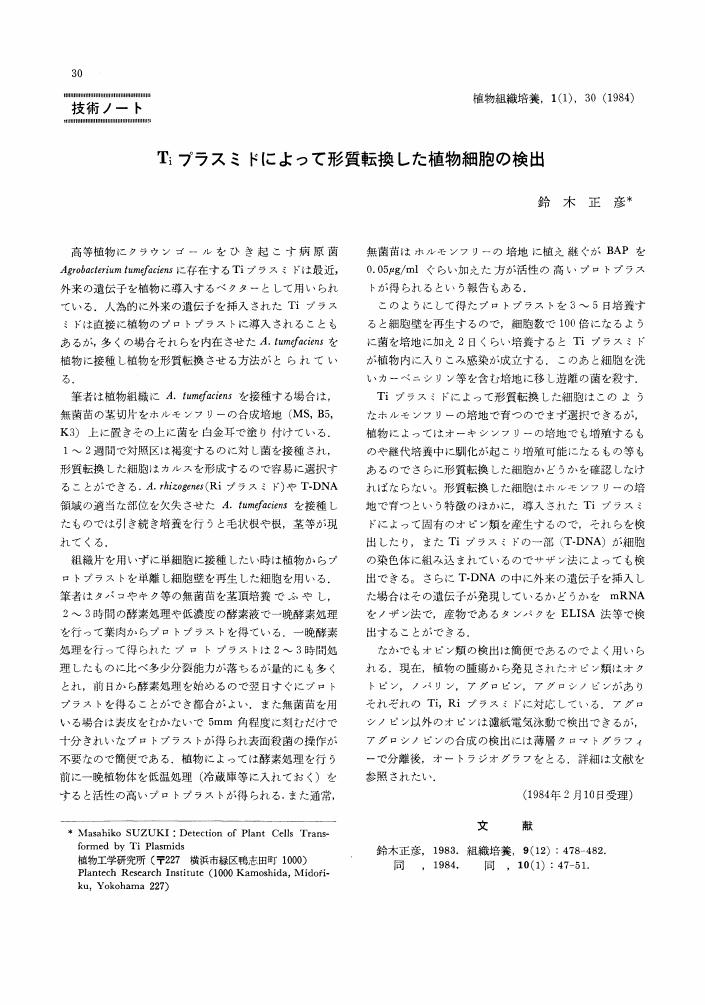2 0 0 0 OA 転位観察における磁気的性質の利用
- 著者
- 馬越 佑吉
- 出版者
- 社団法人 日本金属学会
- 雑誌
- 日本金属学会会報 (ISSN:00214426)
- 巻号頁・発行日
- vol.19, no.9, pp.645-654, 1980-09-20 (Released:2011-08-10)
- 参考文献数
- 31
2 0 0 0 IR 対人関係における親密さとスキンシップ許容度--韓国人大学生の分析結果を中心に
- 著者
- 曹 美庚
- 出版者
- 九州大学大学院比較社会文化学府
- 雑誌
- 比較社会文化 (ISSN:13411659)
- 巻号頁・発行日
- vol.16, pp.73-85, 2010
本研究は、韓国人大学生の対人関係における親密さとスキンシップ許容度について調査・分析し、韓国文化に対する異文化理解を促すことを目的としている。対人関係において親密感が高い相手とは密接距離を維持し、親密感の薄い相手とは個体距離を維持するという既存研究、ならびに密接距離帯あるいは個体距離帯にいる同性同士では、男性より女性のほうがスキンシップの機会やスキンシップ部位が広いという既存研究より、親密感の高低と性別によってスキンシップに対する許容度に相違があるという仮説を導いている。具体的には、親密感の高い相手の場合、密接距離を維持する関係上スキンシップをとる傾向も強いであろうと考え、親密感の高低がスキンシップ許容度に影響するという仮説を導き、仮説の検証を試みた。また、女性同士のスキンシップに対する許容度が男性同士のスキンシップに対する許容度より高いであろうという仮説については、自分と他者、あるいは他者と他者のいずれにおいても女性同士のスキンシップに対する許容度が高く示され、当該仮説が検証された。なお、今回の調査・分析により、仮説検証のみならず、韓国人大学生は全体的にスキンシップ許容度が高いこと、女性同士のスキンシップに対する女子学生の許容度がとりわけ高いことなどが明らかになった。
2 0 0 0 OA 人口減少下におけるインフラ整備を考える視点
- 著者
- 宇都 正哲
- 出版者
- 公益社団法人 日本不動産学会
- 雑誌
- 日本不動産学会誌 (ISSN:09113576)
- 巻号頁・発行日
- vol.25, no.4, pp.43-49, 2012-03-16 (Released:2016-10-19)
- 参考文献数
- 3
- 被引用文献数
- 1 2
The infrastructure management of Japan has problems in both sides of supply and demand. In the demand side, the problems exist in the overseas relocation of industrial activities and also the decrease in population. In the supply side, on the other hand, the problem is the high renewal costs of the aging infrastructure. It is actualizing especially in the local area. The infrastructure management is required in a timely manner. The time management is an important viewpoint in that case. It is required to practice optimization of an infrastructure level in accordance with the demand, and it is important to disclose related the infrastructure information for that purpose.
- 著者
- 石川 結貴
- 出版者
- 全国保険医団体連合会
- 雑誌
- 月刊保団連 (ISSN:02885093)
- 巻号頁・発行日
- no.1282, pp.22-27, 2018-11
- 出版者
- 日経BP
- 雑誌
- 日経ニューメディア = Nikkei new media (ISSN:02885026)
- 巻号頁・発行日
- no.1689, pp.3-4, 2020-01-20
この方針は、ローカル5Gの利活用を進めようとする地方自治体や地域系などの事業者、ベンダー各社などにとっては、非常に大きなインパクトのある朗報であろう。一方で、全国MNOであるソフトバンクと楽天モバイルの2社は、受け入れがたいと強く反対の意向を示し…
- 出版者
- 日経BP社
- 雑誌
- 日経コンピュータ = Nikkei computer (ISSN:02854619)
- 巻号頁・発行日
- no.911, pp.122-124, 2016-04-28
センターシステムは、年末年始を除き、土日を含む毎日午前8時から午後8時まで稼働する。抽選日の午後6時30分までに販売が終了し、6時45分の抽選開始までの間に、抽選対象くじの販売数や売上金額のデータについてシステムが自動的にチェックする。 実は日本宝…
- 著者
- Teppei Sugimoto Kota Katayama Hideki Kandori
- 出版者
- The Biophysical Society of Japan
- 雑誌
- Biophysics and Physicobiology (ISSN:21894779)
- 巻号頁・発行日
- pp.bppb-v18.012, (Released:2021-04-16)
- 被引用文献数
- 6
2 0 0 0 OA IRCAMの「音楽の心理音響学」シンポジウム
- 著者
- 三浦 種敏
- 出版者
- 一般社団法人 日本音響学会
- 雑誌
- 日本音響学会誌 (ISSN:03694232)
- 巻号頁・発行日
- vol.33, no.12, pp.686-690, 1977-12-01 (Released:2017-06-02)
- 著者
- 厳 紹璗
- 出版者
- 国際日本文化研究センター
- 雑誌
- 日本研究 : 国際日本文化研究センター紀要 (ISSN:09150900)
- 巻号頁・発行日
- no.12, pp.33-72, 1995-06-30
奈良時代の日本古代文学にきわめて重視すべき作品『浦島子伝』がある。その題材や文体などすべては中国唐代の「伝奇」にたいへん類似している。本稿ではこれを「漢文伝奇」と名付けた。『浦島子伝』と「浦島伝説」は二つの異なる発展段階の作品である。――「浦島伝説」は「伝奇」に先行する段階の作品であり、完全に民間のものであり、それに対して、『浦島子伝』は文人の創作の作品である。日中古代文学が神話や伝説から物語文学へと発展する過程には、「漢文伝奇」の創作を主な内容とした過渡期的段階がある。『浦島子伝』こそ「漢文伝奇」の代表的な作品である。伝播の歴史が古いので、『浦島子伝』のテキスト間には多岐にわたる意義の相違が生じた。文化史学的立場から考察を加えるとすれば、それぞれ異なったテキストの間には、事実上前後する伝承関係がある。これらが示す伝承の発展こそ、伝記文学の日本化の過程である。本稿では『浦島子伝』のテキストを四つの系統に分けた。『古事記』の「火遠理命神話」、『日本書紀』の「浦島伝説」、及び『萬葉集』にある「水江浦島子」という三つの神話と伝説が、この伝奇を構成した日本民族文化のルーツである。その中で、「水江浦島子」は日本先住民の「汎海洋崇拝」という心態を表し、「浦島伝説」は渡来人(帰化人)の「特定生物に対する崇拝」という心態を表しているのであるが、しかし、「火遠理命神話」には作品の創作に創造的な空間が加えられているのである。また、文献学的に実証的な手段を取ると、この『浦島子伝』からそこに融合された東アジア文化(主に中国文化)の要素を引き出すことができるのである。本稿ではこれらの要素を「媒体」と名付けた。この伝奇が媒体とした中国文化の要素には、主に四つの様式がある。Aは、秦漢から魏晉にかけての「神女文学チェーン」で、Bは、『遊仙窟』を始めとした唐代伝奇で、Cは、「神仙観念」と「亀崇拝」及び「情愛のリビドー」を融合した「蓬莱文化」、Dは、「丹石の煉」と「房中の術」をもって「不老不死」を目的とした道教理念である。『浦島子伝』は、一方で日本民族の神話や伝説を継承しつつ、また、一方で東アジア文化と多く関連している。この特徴は、まさに日本物語文学形成における文化の豊かさ、及びそこに内在するメカニズムの複雑さを表しているのである。
- 著者
- 上原 伸元
- 出版者
- 日本マス・コミュニケーション学会
- 雑誌
- マス・コミュニケーション研究 (ISSN:13411306)
- 巻号頁・発行日
- vol.90, pp.195-196, 2017-01-31 (Released:2017-10-06)
2 0 0 0 OA Tiプラスミドによって形質転換した植物細胞の検出
- 著者
- 鈴木 正彦
- 出版者
- Japanese Society for Plant Cell and Molecular Biology
- 雑誌
- 植物組織培養 (ISSN:02895773)
- 巻号頁・発行日
- vol.1, no.1, pp.30, 1984 (Released:2010-04-30)
- 参考文献数
- 2
2 0 0 0 OA 社会保障とベーシック・インカム
- 著者
- 木村 富美子 Fumiko Kimura
- 出版者
- 創価大学通信教育部学会
- 雑誌
- 通信教育部論集 (ISSN:13442511)
- 巻号頁・発行日
- no.16, pp.52-68, 2013-08-11
2 0 0 0 OA 体験から学ぶ浣腸時の看護
- 著者
- 川西 千恵美 川畑 摩紀枝 津田 紀子 野崎 香野
- 出版者
- 高知女子大学家政学部衛生看護学科
- 雑誌
- 高知女子大学看護学会集録
- 巻号頁・発行日
- vol.11-12, pp.18-23,
2 0 0 0 OA 十返舎一九著『越中楯山幽霊邑讐討』の研究(その1)
- 著者
- 福江 充
- 出版者
- 北陸大学
- 雑誌
- 北陸大学紀要 = Bulletin of Hokuriku University (ISSN:21863989)
- 巻号頁・発行日
- no.49, pp.97-141, 2020-09-30
Tateyama in Etchū province was well known by Heian-era Japanese people as a sacredmountain that contained an actual hell. It was believed that all Japanese who committedsins during their lifetimes would fall into Tateyama’s hell, and that Tateyama was a sacredsite where the living could meet the dead.Among the many works published during the second half of the Edo period by the popularand prolific playwright and novelist Jippensha Ikku (1765~1831) are two that took upthe theme of Etchū’s Tateyama. Ikku published Etchū Tateyama Yūrei-mura Adauchi in1808 and “Etchū Tateyama sankei kikō” in the eighteenth volume of Shokoku dōchū kaneno waraji in 1828.The latter work has been transcribed and annotated by a number of scholars, and somehave studied it in the context of Tateyama belief; to some extent it has been introduced tothe academic world. The former work, however, has not received the same attention interms of transcription--it has only been quoted by a few scholars--and there has been nointroduction or analysis of the work as a whole.It is thought that Ikku travelled to Echigo, Etchū, and Kaga in 1826, and that he basedShokoku dōchū kane no waraji (1828) on that experience. Like one of his most famousworks, Tōkai dōchū hizakurige , it is comedic. By contrast, Etchū Tateyama Yūrei-muraAdauchi of 1808, published twenty years earlier, was composed with then-popular revengenovels in mind, as Ikku himself indicated at the beginning of the volume. In Ikku’s novel,a young couple falls in love, the woman gets pregnant out of wedlock, they elope, the manis murdered by a middle-aged male stalker, and the victim appears as a ghost to thewoman he loves. Ikku further incorporated an old story about Tateyama’s ghost town. Hethereby combined various motifs and genres to create this popular and entertaining novel.Ikku’s two Tateyama-related works can be classified into different genres, but bothindicate a shift in perception of Tateyama from a sacred site of intense religious practiceduring the classical period to a mountain that welcomes tourism and offers entertainmentduring the Edo-period.In 1814, six years after the publication of Etchū Tateyama Yūrei-mura Adauchi, while under the rulership of Kaga domain’s Maeda family, what had long been Tateyama’smountain-meditation route was circumvented. At the same time, the facilities at theTateyama hot-springs (close to the mountain’s caldera and the many mountain peaks in thearea) were restored and a direct route was established from the mountains to the hotsprings.It was the start of a thriving hot-springs business. As a result of thesedevelopments, priests of the town Ashikuraji in Tateyama’s foothills, who until then hadhosted pilgrims who climbed the mountain as religious practice, had to adjust to an increasein secular tourists and pleasure hikers. The sudden decrease in pilgrims put Ashikurajipriests into a very difficult practical and economic position. They had to rethink theirdoctrinal teachings and customs, such as appealing to women who had been excluded fromthe sacred mountain. Kaga domain’s strategies for stimulating the local economy duringthe latter half of the Edo period threatened the older economy of Tateyama as a sacred site.Etchū Tateyama Yūrei-mura Adauchi reveals that Ikku witnessed these socio-economicchanges and that he was aware of--and poked fun at--Tateyama’s traditional sacredcharacter. We also sense from this work that Ikku was prescient about the mountain’s future.In this article I first transcribe and introduce Etchū Tateyama Yūrei-mura Adauchi .Then I analyze its contents and contribute to a deeper understanding of this work as ahistorical source important to research of Tateyama’s religious history.
2 0 0 0 OA 2.高齢者の転倒リスクの評価
- 著者
- 神崎 恒一
- 出版者
- 一般社団法人 日本老年医学会
- 雑誌
- 日本老年医学会雑誌 (ISSN:03009173)
- 巻号頁・発行日
- vol.48, no.1, pp.33-35, 2011 (Released:2011-03-03)
- 参考文献数
- 3
2 0 0 0 OA Haxamāniš 朝初期における小家畜管理
- 著者
- 川瀬 豊子 Toyoko Kawase
- 出版者
- 国立民族学博物館
- 雑誌
- 国立民族学博物館研究報告 = Bulletin of the National Museum of Ethnology (ISSN:0385180X)
- 巻号頁・発行日
- vol.4, no.1, pp.43-78, 1979-07-30
Persepolis Fortification Tablets (PFT) deal with administrativetransfers of foodstuffs from 509 to 494 B.C., i.e., from thethirteenth to the twenty-eighth year of Darayavau-I. Throughthe investigation of these tablets, this essay attempts to reconstructtentatively the major outline of the royal management of UDU.NITA.Ninety-three texts referring to UDU.NITA were extractedfrom PFT, to which was added Fort. 6764, published by G. G.Cameron. The following facts emerged from the detailedanalysis of the texts:1) The royal nutanus (stockyard) was the central organization ofUDU.NITA breeding in the royal economy;2) Breeding was based on the consignment system;3) A form of cattle tax (bazis) was levied by the royal court;4) The use of meat and hides is confirmed by the texts, whereasthat of wool and milk is only suggested, as for products derivedfrom UDU.NITA. In additon, UDU.NITA were rituallysacrificed.5) The consumption of UDU.NITA, was apparently restrictedin daily life, and evidently, the interest of the royal court centeredon increase of UDU.NITA and utilizing them alive. It is thoughtthat UDU.NITA were not regarded as consumer goods, butrather as savings;6) The consignment system and the levy of bazis seem to haveshared the functions of linking the royal economy with the cattlebreeders, from which it may be concluded that in addition totheir economic functions, the consignment system and the levy ofbazis aimed at the close interaction with the cattle breeders.




